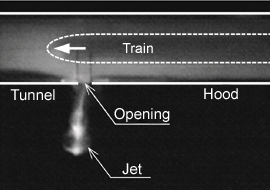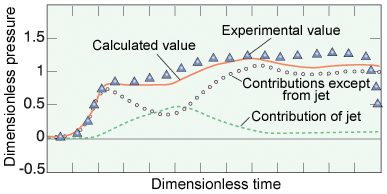| 7. Clarification of Compression Wave Generation when a Train Enters a Tunnel Entrance Hood | |||||
|
Entrance hoods are currently set up at the portals of many Shinkansen tunnels to reduce micro-pressure waves. An entrance hood is an extended structure with a cross section about 1.4 times that of the tunnel, and has openings on its sidewall and/or ceiling. When a train enters a tunnel with an entrance hood set up at its portal, the phenomenon of compression wave generation becomes very complex and has not been clearly illustrated. In collaboration with Boston University, a physical model for the phenomenon was therefore created to establish a foundation for the analytical prediction of such compression waves. The study was conducted experimentally and theoretically by dividing the phenomenon that takes place when the nose of a train enters a hood into the following basic phenomena: interference between the hood entrance and the nose of a train; interference between sidewall openings and the nose of a train; interference between the hood/tunnel junction and the nose of a train; multiple reflection of the compression wave; jets blown out through the sidewall openings; a vortex ring formed at the hood entrance, and friction on the train side surface and tunnel wall. As an example, Fig.2 shows the results clarified by theoretical analysis of the jet (Fig.1) blown out through the sidewall opening of the hood and its influence on the compression wave in the tunnel. By taking the contribution of the jet into consideration, the waveform of the compression wave can now be predicted more accurately. In the future, a fast, accurate method for calculating the compression wave generated when a train enters the entrance hood will be developed by combining all the findings made to date. Although the design of entrance hoods and the optimization of train nose shapes have conventionally been carried out using model experiments and repeated large-scale numerical simulations, this new method will make the process extremely efficient.
|

